A look at Windows 8 Tablets running on TI, Qualcomm, Nvidia, AMD and Intel silicon
by Brian Klug on September 14, 2011 9:00 PM ESTThis afternoon (and yesterday) we had a chance to meet with a number of SoC vendors who have partnered with Microsoft for Windows 8. Each of them has their own individual reference tablet running Windows 8, and today we had a chance to survey the landscape and get photos of all the tablets. We started with ARM, then looked at x86 based tablets. Of course, the real goal with Windows 8 is to abstract as much of the difference between these two platforms away.
Unfortunately, all of the ARM vendors were required to keep their tablets under glass and out of the way of physical contact per Microsoft instruction. Microsoft isn't ready to show off the ARM version of Windows 8 for a variety of reasons at this point (at least without a Microsoft rep. present), but we still got a chance to at least take a look at what there is now. Microsoft is encouraging tablet makers to target either a 10.1" or 11.6" form factor with 1366x768 resolution (ed: Metro will require 1024x768 as a minimum, so 1280x720 displays don't meet Microsoft's requirements).
Texas Instruments
First up is TI, whose development platform was demoed playing back the 1080p30 H.264 baseline video shown in the keynote fluidly in windows media player with a split-screen view. One tablet displayed the start menu, another displayed two split screen games. TI's development platform as shown right now is running on OMAP 4430, which again consists of two ARM Cortex A9s at 1.0 GHz and PowerVR SGX 540 graphics. Windows 8 won't launch on OMAP 4430, however, instead it'll launch on the more powerful OMAP 4470 platform with PowerVR SGX544 graphics and a 2D display compositor. The reason is partly due to SGX544 having full Direct3D 9.3 compliance, partly because it's an all around faster platform. I'm told that right now there's some Direct3D emulation going on as well for all the SoCs that don't support Direct3D 9.3.
I also recorded a short video showing the TI Windows 8 tablet in action.
Qualcomm
My next stop was Qualcomm, whose current development tablet runs on an MSM8660 SoC, which consists of two scorpion cores and Adreno 220 graphics. Qualcomm took the tablet out of the glass box for us and showed a quick demonstration of the start menu scrolling back and forth, and the IE10 mobile view working and scrolling around.
Unfortunately we weren't allowed to shoot video of the tablet while that demo was running, but we did grab some photos of the tablet without the glass box. Performance on the start menu looked to be above 30fps the whole time but not buttery smooth like the x86 tablets we've seen so far.
Just like TI, Qualcomm won't go to market with the SoC they're demonstrating Windows 8 working on today, instead they'll use the more powerful dual core Krait MSM8960 at first and quad core Krait APQ8064 later on. Dual core krait SoCs (eg 8960, 8270, 8260A) come with Adreno 225, quad core krait (APQ8064 and others) come with Adreno 320, both of which are Direct3D 9.3.
NVIDIA
We've seen NVIDIA's Kal-El quad-core A9 based tablet a few times now, and found it out on the floor, also behind glass. Unlike the other vendors, NVIDIA hasn't said anything about going to market for Windows 8 with anything but Kal-El, and I don't see any reason why they should either.
The Kal-El development tablet was seated in a nice looking dock with what looks like one USB 3.0 port and a full size HDMI port.
AMD
Switching over to the x86 camp, we have AMD, who showed us two tablets running on Brazos - the Acer Iconia Tab W500 and MSI WindPad 110W, which use a C-50 and Z-01 APU, respectively. Displays on these are 1280x800 and support capacitive touch just like you'd expect for Windows 8.
Both the MSI WindPad and Iconia Tab felt snappy and responsive running the same Windows 8 Developer Preview build that we've used on the Samsung developer hardware. Subjectively, the WindPad's capacitive panel was more responsive and less prone to errant touch recognition than the Iconia, though both were more than useable with Windows 8.
Intel
Last but not least is Intel's own development tablet, which is running an unnamed 32nm SoC. Intel was suspiciously silent about which particular SoC was inside this device, and you'll notice that it too is locked down in a plastic box, lumping it squarely in the next-gen SoC category for Microsoft.
It's possible this is Medfield, it's also possible this is some 2nd gen 32nm Atom SoC. Hopefully we'll find out more as Windows 8 starts getting closer to launch.


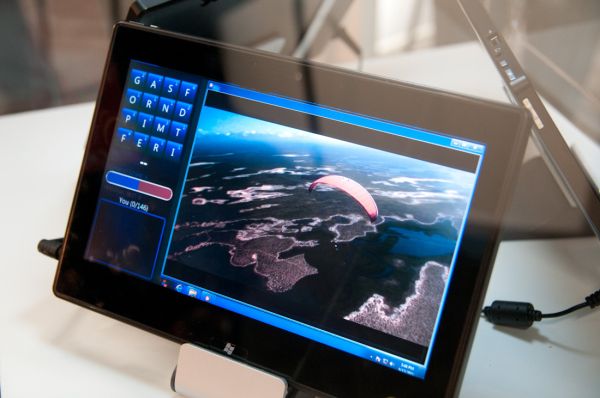
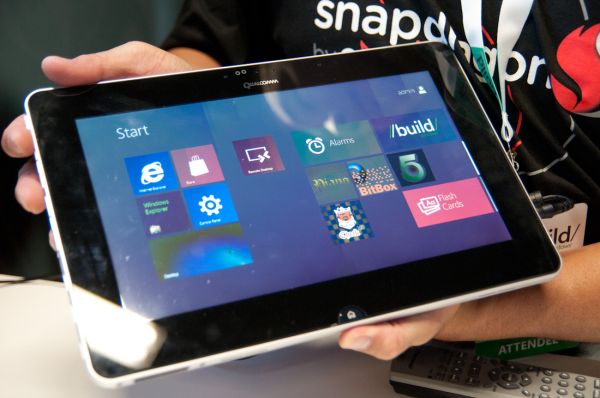
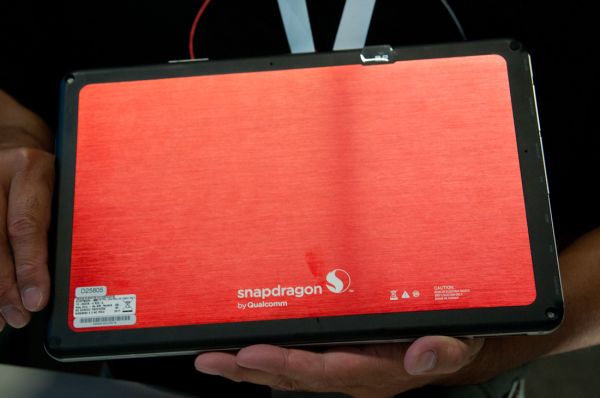
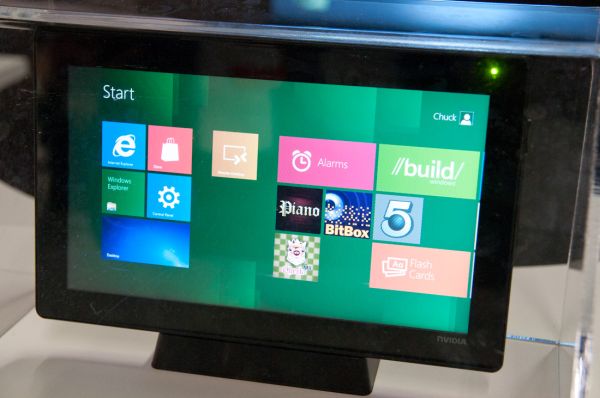
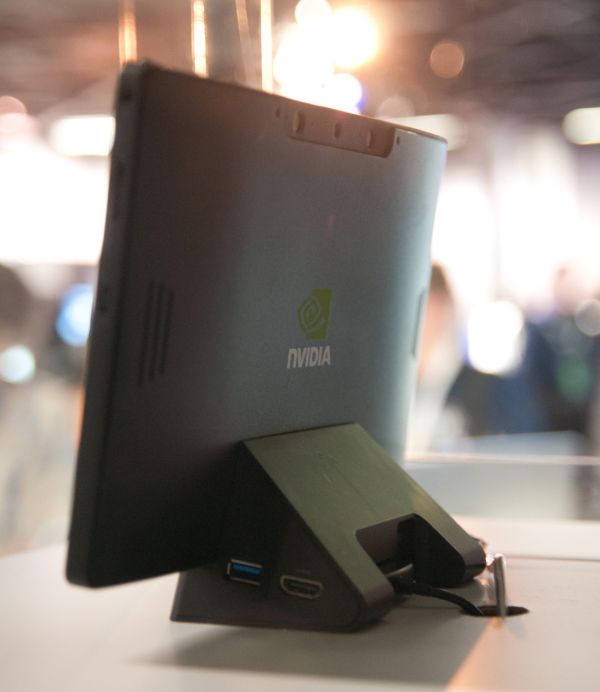
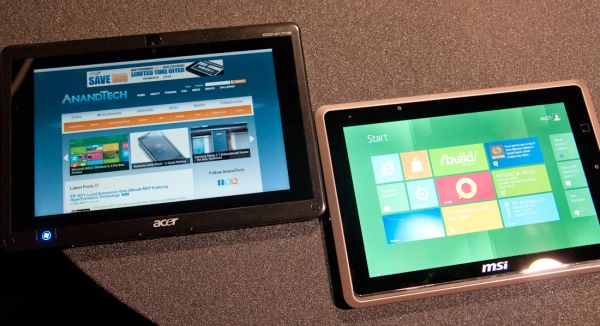
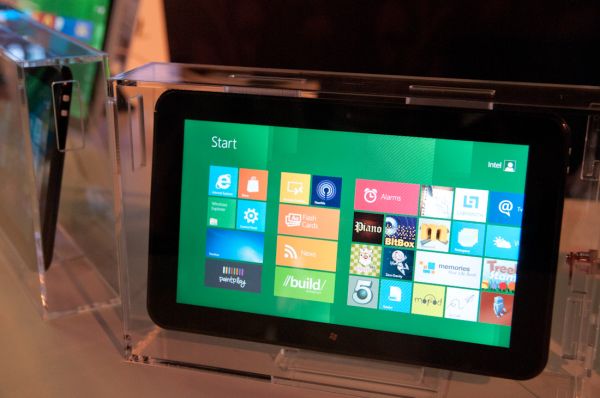














92 Comments
View All Comments
Aries1470 - Saturday, September 17, 2011 - link
Ok, I have read all the comments up to now, excluding watching 2½ (2.5) hours of video.My thought is this. M$ already dominate the desktop hence WinTel. They use to have a large market share until WinMo5-6.5. Then they went downhill. They did the tablet thing, but the cpu's and batteries were not worth it, and the average joe was not interested back then due to price/performance.
Come now newer ARM architectures, other operating systems aka iOS, Android (linux), QNX/BB and now nearly dead webOS and the rising sales of tablets/ slates they want in.
With their name behind them, they will dominate sooner rather than later the tablet market and phone too.
Apple can NOT touch them, even IF the designs are similar due to that they are running MS!!! Please read crApples own statements in current lawsuits, that the vendors can sell M$ but not Android, since that is most of their fit. As for the form factor, they will find it harder with MS behind the makers due to conflicting / overlaping patents. Don't get me wrong, crApple will try...
M$ has already demoed a re-compile as mentioned earlier. Also, if the programmers followed strict guidelines, then their programmes can and will easy to re-compile to run from x86 to Arm code. Now if game developers used standard DX 9 calls, and not some 'work-arounds' or 'optimisations' for said gpu (aka AMD/Ati or nVidea) then there will not be that many headaches either.
On the other hand, also expect to see a few 'dual/multi' boot offerings too, that will be running Android/Win8 Arm either seperataly or concurrently.
Now, the ball is in crApples court, they WILL need to lower their prices & profit margins sooner rather than later to be competitive and have dual running machines that can run OS X & iOS! They will have similar fully fledged tablets too, just that we will have to wait and see them.
Now to just wait for Omap5 to start shipping from T.I., with a pico Projector and let the fun begin.
p.s. Indemnity notification: Most of the above is presumed to be speculation and no lawsuits will be entered in to or entertained ;-)
fteoath64 - Sunday, September 18, 2011 - link
To add: MS sees the future as tablets/handsets and Clouds. Desktops will get more and more scarce while laptops replace desktops in workplaces and homes. So lets see what OS MS has for a tablet ?. Only Win8 there ain't a choice for them as WP7.5 is strictly for handsets and they had to make that stick or else they will have to buy some company like RIM.So they yet again tries to shoehorn Win7+launcher/shell into ARM. I am betting this will fail because of "tablets and Cloud" model. Primarily because the tablet landscape has gone past Version 2.0, now shooting for V3.0 in both hardware and software technologies.
MS betting on ARM for Win8 counts on the hope that the hardware will scale faster than Intel ever did (or wanted to). This might make it good enough but the price point has to be right as well. In which case, it is severely disadvantaged. The battle is innovation-speed vs price-point. The current leader is HoneyComb and IOS is not far behind. Of course Apple can cut the prices in a price war to hurt their competitors. That might buy them time.
If a small company like Fusion Garage can ship a tablet for $299 with HoneyComb like OS functionality, then one can see a price war coming very soon on the tablet market.